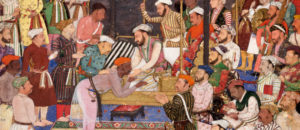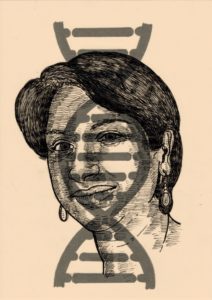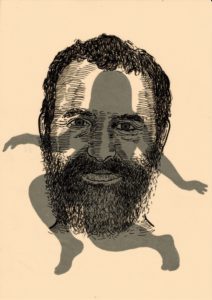Ardhakathanak: A Commoner’s Discovery Of The Mughal Milieu
Abstract
The Ardhakathanak by Banarasidas is often considered the first autobiography in Hindi. Completed in the year 1641, the book provides us with a commoner’s understanding of the Mughal world. Often subjected an imperial bias, the book is a wildly neglected source of history. The study attempts to highlight various societal norms and ethics as evidenced by the Ardhakathanak. It undertakes a thematic division in understanding medieval Indian society, focusing on merchant practices, societal norms and Jain religion. Various aspects of a middle class man’s life are unraveled through the course of this study, including education, business decisions, wealth, family, domesticity, religious assimilation, rationality and self-discovery.
The study also embarks on an analysis of the Varanasiya sect of Jain religion briefly. Finally, emerging trends of individuality are highlighted. The study culminates with a brief account of how underutilized this primary source remains despite obvious merits to it.
Keywords: Banarasidas, Ardhkathanak, autobiography, merchant practices, religious pursuits, cultural history.
1. Introduction
The development of the literary genre of autobiography is a fairly ancient one, with St. Augustine’s autobiographical work ‘Confessions’ written in 399 CE. However, the understanding of the term autobiography to be a form of ‘self life writing’ is a recent phenomenon. The Oxford English Dictionary credits Robert Southy to be the progenitor of autobiography in the year 1809. However we find a reference to autobiography or self-biography being used by William Taylor in the Monthly Review of 1797.[i]The motivations for committing one’s life to writing are often religious in nature, to record stages in an individual’s life by which they lose their own identity to celebrate God’s divine power.[ii] Today, these works have become a prominent source of history and are extensively researched to arrive at a deeper understanding of the period it was written in. The earliest known biographical work that was produced in India is the Harshacharita written by Banabhatta in the 7 th century CE. However, truly autobiographical accounts only appear in India with the advent of Mughals. Among these, Baburnama was the earliest, and records Babur’s life between 1483 to 1530.[iii] The autobiographies written during this period were meant to preserve a person’s family history and good deeds for posterity. Thus, the representation of the subject is in light of the reader’s judgement. Therefore, we may conclude that these writings often lack a humanizing touch that can relate the subject to the reader.
One such piece in the ocean of Mughal writings is Banarasidas’s Ardhakathanak. It was first discovered by Nagari Pracharini Sabha and published by Dr. Mataprasad Gupta in 1943.[iv]
Banarasidas was a Jain merchant who lived during the Mughal Era in India. The title of his autobiography translates to ‘half a tale’. The book was completed in the winter of 1641 in the imperial capital of Agra, when Banarasi was 55 years of age. In Jain philosophy, a full life is considered to be of one hundred and ten years. Thus, the title of Banarasi’s book ‘Half a Tale.’ Although, the tale began to be the story of half a life, Banarasi met his demise only two years after the completion of his book, implying that the story covered his entire life. Written in the language of the Indian heartland, Braj Bhasha. Ardhakathanak is considered to be the first autobiography in Hindi.[v] Much to the contrary to other Mughal works, Banarasidas’s tone throughout the book is that of unabashed candor. Over the course of the book, Banarasi establishes a rapport with the reader and slowly but surely becomes a friend. By the time, we reach Banarasi’s close of life, a feeling of a long and fruitful companionship lingers on with the reader. We know Banarasi’s secrets, sorrows and soaring moments. Unlike other autobiographical works of the contemporary period the emphasis is not on making a perfect man devoid of any flaws, fit to govern the territory of India, but to lay bare before the reader the heart and soul of subject, good or bad.
It is evident from the content of the book and style of writing that Banarasi did not expect his autobiography to be read nearly 400 years later. In fact, there was an understanding that it would only be read by limited audience of friends and kinsmen.[vi] In Banarasi’s own words, the only reason he ventured into the business of recording his life, is ‘let me tell you all my story’.
A Jain from the noble Shrimal family,
That prince among men, that man called Banarasi,
He thought to himself, let me tell my story to all [vii]
Angela Saini – Superieur. De terugkeer van de Rassentheorie
Superieur van de wetenschapsjournalist Angela Saini is een verslag van het uitgebreide onderzoek naar de biologische feiten rondom het begrip ras.
Bestaat er een verband tussen ras en IQ? Welk ras is het beste? Zijn wij één mensensoort of niet? Wat kan het moderne wetenschappelijke bewijsmateriaal ons echt vertellen over de menselijke verschillen, en wat betekenen die vervolgens?
Deze vragen zijn allerminst gedateerd. De rassentheorie beleeft een zorgwekkende comeback, in wetenschap en politiek. Angela Saini onderzoekt in Superieur pseudowetenschappelijk beweringen en theorieën over ras, en toont aan waarom ze onhoudbaar zijn. Angela Saini komt tot de conclusie dat de biologie deze vraag niet kan beantwoorden. Als we de betekenis van ras willen begrijpen, moeten wij begrijpen hoe macht werkt. Een onderzoek van de Verlichting via het negentiende-eeuwse imperialisme en de twintigste-eeuwse eugenetica naar de revival van de rassentheorie in de eenentwintigste eeuw.
Saini toont in Superieur aan hoe macht het idee van ras telkens weer opnieuw vormgeeft, hoe macht de wetenschappelijke feiten beïnvloedt. De betekenis houdt verband met de tijd.
Lang hebben witte mensen van Europese afkomst zich aan de top van de machtshiërarchie bevonden en bouwden hun wetenschappelijk verhaal over de menselijke soort rond dit geloof. Maar geen enkele regio of volk heeft recht op een claim op superioriteit.
‘Ras is het tegenargument. Ras komt in de kern van de zaak neer op het geloof dat we van geboorte anders zijn, diep in ons lichaam, misschien zelfs qua karakter en intellect, en in onze uiterlijke verschijning.’ Het is het idee dat bepaalde groepen mensen bepaalde aangeboren kwaliteiten hebben. Ras, gevormd door macht, heeft een eigen kracht verkregen. Witheid werd de zichtbare maatstaf van de menselijke moraliteit. Sinds de Verlichting hadden veel Europese denkers zich verenigd rond het idee dat de mensheid één was, dat we dezelfde gemeenschappelijke vermogens deelden. Ook al was er een rassenhiërarchie, ook al waren er mindere mensen en betere mensen, we waren allemaal nog steeds menselijk. In de volgende eeuw vroeg men zich weer af, of we echt wel tot hetzelfde soort behoorden: want waarom zagen wij er niet hetzelfde uit en gedroegen we ons niet op dezelfde manier? Het is geen toeval dat de moderne ideeën over ras zijn gevormd tijdens de hoogtijdagen van het Europese kolonialisme, toen de machthebbers overtuigd waren van hun eigen superioriteit. In de VS werd dezelfde verwrongen logica gebruikt om de slavernij te rechtvaardigen. En de wetenschap voorzag het racisme van intellectueel gezag.
De rassentheorie heeft zich altijd op het kruispunt van wetenschap en politiek opgehouden, en van wetenschap en economie. Ras was niet alleen een middel om fysieke verschillen te classificeren, het was ook een manier om de menselijke vooruitgang te meten, en om te kunnen oordelen over de capaciteiten en rechten van anderen, aldus Saini. Ook Hitlers ideologie van rassenhygiëne had geen kans van slagen zonder wetenschappers, zij zorgden voor het theoretisch kader en droegen bij aan het klaren van de klus zelf. Degenen wier ideeën het regime goed te pas kwamen werden gepromoot en gevierd.
In 1950 formuleerde UNESCO, vlak na de Tweede Wereldoorlog, zijn eerste verklaring over ras, waarin de eenheid tussen mensen werd benadrukt in een gezamenlijke inspanning om een einde te maken aan wat wordt gezien als het gevolg van een ‘fundamenteel anti-rationeel denksysteem.’ Alle mensen behoren tot dezelfde soort ‘Homo sapiens’. Het grootste deel van de zichtbare diversiteit is cultureel van aard. Een cruciaal moment in de geschiedenis. Racisme was niet langer aanvaardbaar. Wetenschappers en antropologen gingen grotendeels achter UNESCO staan.
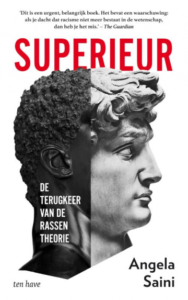 We denken dat de verschrikkingen van de Holocaust en eerdere genocides, de slavernij en het kolonialisme tot een andere tijd behoren. Dat eugenetica een vies woord is. Saini definieert eugenetica als is een berekende manier van denken over het menselijk leven; mensen worden gereduceerd tot louter delen van een geheel, die hun ras omlaag- of omhoogtrekken. Bijna alles wat we zijn is al beslist voordat we geboren zijn. Maar er zijn weer nieuw wegen gevonden om raciale verschillen te onderzoeken, en dat sommige rassen iets beter waren dan de andere. Na de Tweede Wereldoorlog hebben intellectuele racisten nieuwe netwerken opgezet met het doel racisme weer respectabel te maken. De eugenetici en rassentheorie waren niet verdwenen met de ondergang van het naziregime. Ras werd herpositioneerd voor de eenentwintigste eeuw. Ze noemt als een van de voorbeelden de Indiase regering, die in 2018 een commissie in het leven had geroepen om de geschiedenis te herschrijven. Een mythische versie van de geschiedenis zou worden gepropageerd waar in Indiase dominante geloof, het hindoeïsme, in het hele Indiase verleden centraal zou worden gesteld.
We denken dat de verschrikkingen van de Holocaust en eerdere genocides, de slavernij en het kolonialisme tot een andere tijd behoren. Dat eugenetica een vies woord is. Saini definieert eugenetica als is een berekende manier van denken over het menselijk leven; mensen worden gereduceerd tot louter delen van een geheel, die hun ras omlaag- of omhoogtrekken. Bijna alles wat we zijn is al beslist voordat we geboren zijn. Maar er zijn weer nieuw wegen gevonden om raciale verschillen te onderzoeken, en dat sommige rassen iets beter waren dan de andere. Na de Tweede Wereldoorlog hebben intellectuele racisten nieuwe netwerken opgezet met het doel racisme weer respectabel te maken. De eugenetici en rassentheorie waren niet verdwenen met de ondergang van het naziregime. Ras werd herpositioneerd voor de eenentwintigste eeuw. Ze noemt als een van de voorbeelden de Indiase regering, die in 2018 een commissie in het leven had geroepen om de geschiedenis te herschrijven. Een mythische versie van de geschiedenis zou worden gepropageerd waar in Indiase dominante geloof, het hindoeïsme, in het hele Indiase verleden centraal zou worden gesteld.
De hindoe-superioriteit zou sommige Indiërs de kans bieden hun zelfrespect terug te winnen, collectieve trots te laten gelden, en een nieuw gevoel van nationale identiteit bouwen.
We blijven steeds maar terugkomen op ras omdat we er vertrouwd mee zijn. Onze moderne ideeën over ras zijn nauw verbonden met hoe we eruitzien. In biologische termen lijken echter de verschillen niet verder te gaan dan de huid. Het is een vergissing te denken dat de interne verschillen even groot zijn als de externe verschillen lijken. De opkomst van nationalisme en racisme heeft velen van ons verrast. Identiteitspolitiek heeft velen in de greep. Het doel is hetzelfde: het benadrukken van de verschillen ten bate van politiek gewin.
Zij doet geen beroep een gedeelde menselijkheid. Alles om maar ‘superieur’ te zijn.
Angela Saini – Superieur. De terugkeer van de Rassentheorie. Uitgeverij Ten Have, Amsterdam, 2020. ISBN 9789025907174
Angela Saini is wetenschapsjournalist voor BBC Radio. Haar werk is onder andere gepubliceerd in New Scientist en The Economist.
Eerder verscheen bij Uitgeverij Ten Have Ondergeschikt: Hoe kennis over vrouwen ons misleidt en wat we daaraan kunnen doen.
Linda Bouws – St. Metropool Internationale Kunstprojecten
The Art Of Cooking – Hummus With Minced Meat
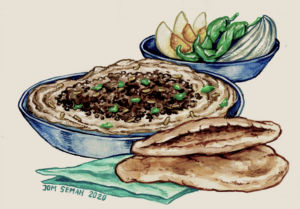 Hummus in Israel can be comparable to Pizza for Italians!
Hummus in Israel can be comparable to Pizza for Italians!
Normally the Hummus can be enjoyed plain or with some extra.
One day in Israel me and my dad visited Caesarea as a couple of tourists, and to our surprise we tumbled upon this Hummus dish topped with warmly spiced minced meat.
That moment left a strong impact on us and I have been making it ever since. The smooth texture of the Hummus combined with the savory bites of the minced meat creates a balanced taste at the moment you scoop as much as you can with a small piece of pita bread.
Trust me, this is the way to eat Hummus, scooping as much as you can with a small piece of pita bread – but do not get it on your fingers, there’s a limit!
Hummus Ingredients:
1 Large Can Chickpeas
Tahini (a paste made from sesame seeds)
2 Cloves of garlic
Lemon juice
Olive oil
Coldwater
Salt
Ingredients for the minced meat:
200-gram Minced meat (you can choose either lamb or beef)
2 Cloves of garlic
Paprika powder
Cumin powder
Salt & Pepper
Cooking oil
Toppings:
Olive oil
Pine Nuts
Fresh Parsley
Making the Hummus:
Inside a blender add the chickpeas, two tablespoons of tahini with the garlic, a pinch of salt, a squirt of lemon juice, and a drizzle of olive oil.
Now it is all about finding the perfect texture and flavor that you want! Keep tasting by adding a small amount of cold water to make the texture smoother.
Add more salt if it tastes too bland, as well as lemon juice if you want to put more zing into it!
There are many types of Hummus out there – however, it is up to you to balance the ingredients to become a favorite of your own taste!
Making the minced meat:
In a cold frypan add the minced meat with a bit of cooking oil, turn on the heat to medium-high and start breaking the meat apart, make sure you don’t keep big lumps. Once the minced meat is almost cooked through, add the minced garlic and all the spices (a teaspoon of cumin and a teaspoon of paprika, as well as, a pinch of salt and pepper). Keep stirring until all the minced meat is covered with the spices, that is until it turns brown and slightly sticky!
Serving:
Place the Hummus in a plate with a dent in the middle, then put the hot minced meat on top!
Top with pine nuts and fresh parsley and a drizzle of olive oil, you can also add some paprika powder on top.
Serve with pita bread, and of course, you may add some raw onion slices, boiled eggs, and pickled spicy peppers.
This is not the most traditional way to eat Hummus, but please give it a try. So, to go back to the comparison between Hummus and pizza, at the end the toppings are up to you.
However, if you want to make a Hawaiian Hummus go for it, but please let me know how this worked out……
Anaclept en cento: de kunst van het herdichten
Buiten de limerick en het sonnet, het ollekebolleke en het Sinterklaasgedicht kent de letterkunde nog veel meer versvormen, waarvan de meeste zich verborgen houden in de nevelen der eeuwigheid.
Een ondergewaardeerd genre is het herdichten. Sommige dichters hebben namelijk niet genoeg aan hun eigen werk, maar vieren hun inspiratie ook bot op andermans verzen, niet zelden zo intensief dat dat hele bundels vol persiflages en parodieën, parafrases en pastiches opgeleverd heeft. Drs. P vulde, als Coos Neetebeem, de bundel Antarctica (’s-Gravenhage, 1980), waarin hij bijvoorbeeld de kern van Willem Kloos’ bekendste sonnet terugbracht tot
Ik ben een God in`t diepst van mijn gedachten
En zit in’t binnenst van mijn ziel ten troon
Maar verder ben ik helemaal gewoon
Met haaruitval en spijsverteringsklachten
en die van A.C.W. Starings’ Oogstlied (‘Sikkels klinken; Sikkels blinken; Ruisend valt het graan. Zie de bindster garen! Zie, in lange scharen, Garf bij garven staan!) tot
Sikkels klinken
Sikkels blinken
Ruisend valt het graan
Als je iemand weg ziet hinken
heeft hij’t fout gedaan
Gerrit Komrij publiceerde een bundel met de alleszeggende titel Onherstelbaar verbeterd (Amsterdam, 1981), waarin hij een aantal gedichten compleet herschreef. ‘De Dapperstraat’ van J.C. Bloem, althans het eerste kwatrijn daarvan,
Natuur is voor tevredenen en legen.
En dan: wat is natuur nog in dit land?
Een stukje bos, ter grootte van een krant,
Een heuvel met wat villaatjes ertegen.
werd bij Komrij
De Kalverstraat
Cultuur is om m’n reet mee af te vegen.
En dan: wat is cultuur nog in dit land?
Een steekje los, een stukje in de krant,
Gekeuvel met wat prietpraatjes ertegen.
If Trump Had Followed Vietnam’s Lead On COVID, US Would Have Fewer Than 100 Dead
As the coronavirus pandemic rages on, exposing to the fullest the glaring weakness of our inequitable health system, and as the unemployment situation goes largely unaddressed, it’s becoming more than obvious that the U.S. is in dire need of fixing. An advanced social welfare state, with a full employment agenda, is the way out, argues world-renowned progressive economist Robert Pollin in this exclusive interview with Truthout. Pollin is distinguished professor of economics and co-director of the Political Economy Research Institute at the University of Massachusetts at Amherst, and co-author (with Noam Chomsky and me) of the forthcoming book The Climate Crisis and the Global Green New Deal: The Political Economy of Saving the Planet.
C.J. Polychroniou: Bob, the coronavirus crisis is wreaking havoc on the economy, but it has also revealed how poorly equipped the United States is in dealing with major economic crises. In fact, as economist Joseph Stiglitz has pointed out, “We built an economy with no shock absorbers.” With that in mind, and with millions of Americans unemployed and even struggling to meet basic needs, can you offer us a straightforward assessment of the Trump administration’s economic response to the coronavirus crisis?
Robert Pollin: The short answer is unequivocal: The Trump administration’s response has been nothing short of disastrous. Let’s begin with figures on lives that have been needlessly lost in the U.S. due to Trump’s toxic combination of indifference, hostility to science, and racism. As of August 17, we are approaching 170,000 deaths from COVID in the U.S., more than triple the total U.S. death toll from fighting in Vietnam. We have no evidence that the death rate will be declining significantly anytime soon. This level of U.S. deaths from COVID amounts to 514 per 1 million people. By comparison, Canada’s death rate is less than half that of the U.S., at around 239 deaths per million, even while Canada itself is also a relatively poor performer. Germany’s death rate, at 110 per million, is 80 percent lower than the U.S., but Germany is still only a middling performer. Among the strong performers, the death rates are 15 per million in Australia, 9 per million in Japan, 6 per million in South Korea and 3 per million in China, even though the virus first emerged in China. If the U.S. had managed the COVID pandemic at the level of, say, Australia, fewer than 5,000 people would have died as of today as opposed to nearly 170,000.
Vietnam is the most extraordinary case. It has experienced a total of 22 deaths in a country of 95 million people, which amounts to a death rate of 0.25 per million. This is for a country in which the average per capita income is about 3 percent of that in the U.S. It is also a country, of course, that U.S. imperialists tried to destroy a generation ago. If the U.S. had handled COVID at Vietnam’s level of competence over the past eight months, then fewer than 100 U.S. residents in total would be dead today from the pandemic.
In terms of managing the pandemic-induced economic collapse, the massive $2 trillion (10 percent of U.S. GDP) stimulus program that Congress passed and Trump signed in March, the CARES Act, did provide substantial support for unemployed workers. Fifty-six million people — 35 percent of the entire U.S. labor force — filed unemployment claims between March and August. For the most part, they all received $600 per week in supplemental support, which more than doubled what most would have received otherwise.
The CARES Act did also deliver huge bailouts for big corporations and Wall Street. Adding everything up, it was clear even at the time of passage that the CARES Act was not close to meeting the magnitude of the oncoming crisis. Among other features, it provided only minimal support for hospitals on the front lines fighting the pandemic, and even less support for state and local governments. The Upjohn Institute economist Timothy Bartik estimates that state and local governments are staring at upward of $1 trillion in budget shortfalls through the end of 2021, equal to between 20-25 percent of their entire budgets. If these budget gaps are not filled in short order, we will begin to see mass layoffs of nurses, teachers, school custodians and firefighters. Of course, these budget cuts will only spread and deepen the ongoing economic crisis.
The Democratic majority in the House of Representatives did pass a second, and even larger, $3 trillion stimulus measure, the HEROES Act, back in May. It included $1 trillion in support for state and local governments. But Trump and the Senate Republican majority have blocked action on this for the past three months. Meanwhile, 16 million workers have now lost their $600 per week in supplemental benefits and state and local governments are teetering on collapse. Trump appears to want to make unemployed workers and public sector programs starve, perhaps so he can appear to swoop in and bail them out right before November’s election. Trump has held out a “compromise” proposal with Democrats. This would feature a payroll tax cut that would permanently decimate Social Security and Medicare. Trump also wants any new stimulus program to also incorporate his current top priority, which is to destroy the U.S. Postal Service in time to prevent people from voting against him through mail balloting.
My Arabic is Mute & Not to be afraid to say the word nostalgia
My Arabic is Mute
Strangled in the throat
Cursing itself
Without uttering a word
Sleeping in the suffocating air
Of the shelters of my soul
Hiding
From family members
Behind the shutters of the Hebrew.
And my Hebrew erupts
Running around between rooms
And the neighbors’ porches
Sounding her voice in public
Prophesizing the coming of God
And bulldozers
and then she settles in the living room
Thinking herself
Openly on the edge of her skin
Hidden between the pages of her flesh
one moment naked and the next dressed
She almost makes herself disappear
In the armchair
Asking for her heart’s forgiveness.
My Arabic is scared
quitely impersonates Hebrew
Whispering to friends
With every knock on her gates:
“Ahalan, ahalan, welcome”.
And in front of every passing policeman
And she pulls out her ID card
for every cop on the street
pointing out the protective clause:
“Ana min al-yahud, ana min al-yahud,
I’m a Jew, I’m a Jew”.
And my Hebrew is deaf
Sometimes so very deaf.
Not to be afraid to say the word nostalgia
Not to be afraid to say
The word nostalgia
Not to be afraid
To feel longing
Not to be afraid to say
I have a past
Placed in a box
Of locked-up memory
Not to be afraid
To buy myself some keys
To press my eyes to keyholes
Until it all opens
Until I can steal a glance
Into me
Not to be afraid to say
I’m a forgetful man
But I have a memory
That wouldn’t forget me.
Translated by Dimi Reider
